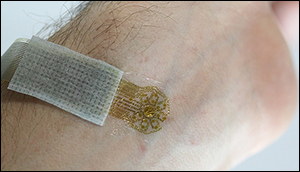Flexible Sensors Measure Blood Flow Under the Skin
13. 11. 2015 | University of Illinois at Urbana-Champaign | news.illinois.edu
Engineers have developed a device platform that combines electronic components for sensing, medical diagnostics, communications and human-machine interfaces, all on an ultrathin skin-like patch that mounts directly onto the skin with the ease, flexibility and comfort of a temporary tattoo.
The circuit bends, wrinkles and stretches with the mechanical properties of skin. The researchers demonstrated their concept through a diverse array of electronic components mounted on a thin, rubbery substrate, including sensors, LEDs, transistors, radio frequency capacitors, wireless antennas, and conductive coils and solar cells for power.

The patches are initially mounted on a thin sheet of water-soluble plastic, then laminated to the skin with water – just like applying a temporary tattoo. Alternately, the electronic components can be applied directly to a temporary tattoo itself, providing concealment for the electronics.
Skin-mounted electronics have many biomedical applications, including EEG and EMG sensors to monitor nerve and muscle activity. One major advantage of skin-like circuits is that they don’t require conductive gel, tape, skin-penetrating pins or bulky wires, which can be uncomfortable for the user and limit coupling efficiency. They are much more comfortable and less cumbersome than traditional electrodes and give the wearers complete freedom of movement.
Read more at University of Illinois at Urbana-Champaign
Image Credit: University of Illinois at Urbana-Champaign
-jk-




